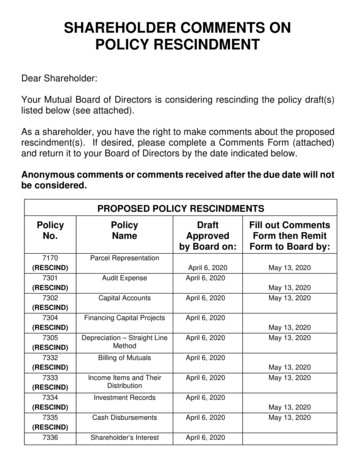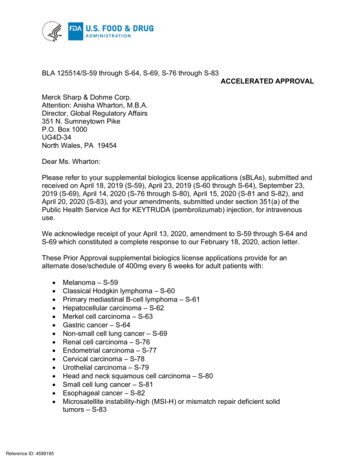
Transcription
H April 2020Technology ToolboxResource Guide Technology Toolbox
An in-vehicle system designed to increase warning and reaction time for incidents. Onesecond of additional warning time reduces likelihood of a crash by 60%; five seconds reduces Globallikelihood by 95%.An in-vehicle system of sensors that detects when another vehicle, motorcycle, or a bicycle isin the vehicle’s blind spot and sounds an alarm or illuminates a warning light.AutomaticEmergencyBraking/ForwardCollision WarningBlind Spot WarningSystemsIn-Vehicle, Pedestrianand BicycleIn-VehicleTier II: LLTier III: EEETier II: LLTier III: EEEIntelligent Transportation Systems & Technology Based Crash Countermeasures ToolboxA system of license plate reading optical speed cameras paired with radar, microwave,Bluetooth, or laser technology that measures the speed of oncoming vehicles and issuesautomated citations for speeding vehicles.Automated SpeedEnforcementCamerasOn-Road, Site Specificor SystematicTier I: M, OTier II: LL, MMGlobalGlobalGlobalAn in-vehicle system of sensors and software that measures the speed and distance fromsurrounding vehicles to match speed and maintain a pre-programmed following distance.Adaptive CruiseControlDeployedIn-VehicleDescriptionTier II: LLTier III: EEETechnologyCountermeasure TypeHigh Risk BehaviorApplicable StrategiesTable 1: Deployed SolutionsWCapital Costs are ranked Low (L), Medium (M), or High (H) on the following scale: Low: 0 - 100,000, Medium: 100,000 to 1,000,000, High: 1,000,000 for single site deployments.Impacts are ranked Low (L), Medium (M), or High (H) based on their measured reduction in crashes and deployment performance.All TypesAll TypesAll TypesRear EndCrash TypesMitigatedLLLLCDC StudyUSDOT Congressional TestimonyUSDOT GuidelinesNCHRP StudyNHTSA Literature ReviewPBIC Review StudyVisionZero Planning Network Resource CenterNHTSA System AnalysisFHWA CMF Clearing House 2009IIHS StudyNHTSA StudyNHTSA Ped StudyNHTSA UK StudyIIHS and General Motors StudySafeCar.gov StudyFMCSA CMV StudyConsumer Reports SurveyFHWA StudyFHWA Study and GuideFHWA GraphicFMSCA Rule MakingFHWA Large Scale StudyNTSB StudyFreight Blind Spot StudyNIH Sensor StudyNHTSA StudyUSDOT StudiesNHTSA Performance EvaluationCapital CostsNHTSA Behavior StudyNHTSA Old/Young Driver StudyFHWA StudyVirginia Tech Transportation Institute StudyFHWA StudyEvaluation, Deployment, and Guideline ReferencesAppendix A: Intelligent Transportation Systems & Technology-Based Crash Countermeasures ToolboxApril 2020MHHMImpact1
A mobile application designed for freight truckers to locate the nearest emergency truckparking in the event of severe weather to avoid stranding.An in-vehicle system of optical cameras and algorithms designed to watch roadway stripingand center the vehicle in lane by steering the vehicle for the driver.Emergency TruckParkingLaneDeparture/LaneKeeping AssistOn-Road Site SpecificOn-Road Systematic,Organizational, DriverBehaviorIn-VehicleTier I: MTier II: LLTier II: LLTier III: EEEIntelligent Transportation Systems & Technology Based Crash Countermeasures ToolboxVMS signs equipped with radar to measure vehicle speed. Speed measurements aredisplayed for the driver and may include ‘Slow Down’ messages.Dynamic SpeedFeedback SystemsTier I: I, MTier II: LLTier III: BBBAll TypesAll TypesAll TypesAll TypesCrash TypesMitigatedGlobalRoadwayDeparture,AngleUnited States All TypesGlobalGlobalAn in-vehicle system of sensors that monitors the driver for physiological signs of fatigue andprovides direct feedback to the driver in the form of an alarm.Drowsy DriverDetection SystemsIn-VehicleTier II: LLTier III: EEEGlobalA function of the latest mobile device operating systems that activates when device speedexceeds 15 MPH and prohibits notifications and use while driving. Alternatively, the user maymanually activate the feature.Do Not DisturbWhile DrivingIn-Vehicle,On-Road SystematicTier I: MTier II: LLTier III: EEEGlobalA vehicle interlock attached to a breathalyzer on vehicle dashboards currently used to ensurecompliance for DUI offenders. Legislators are evaluating whether to make this or similarequipment standard on all new vehicles.BreathalyzerVehicle InterlockIn-VehicleTier I: B, M, OTier II: BB, LLTier III: EEEDeployedDescriptionTechnologyCountermeasure TypeApplicable StrategiesHigh Risk BehaviorCapital CostsLLLLLLEvaluation, Deployment, and Guideline ReferencesNHTSA 2014 GuideNCSL Law Code ReviewArizona DOT GuideWyoming DOT GuideColorado Dept. of Revenue DUI HomepageNHTSA Case StudiesNHTSA Countermeasures That WorkCDC ReportAmerican Journal of Public Health Research ReportFHWA AbstractColorado DOT “Get Turned On”FMSCA RuleNHTSA Crash StatisticsNHTSA Investigation and ProsecutionApple How-ToCDC ReportEverDrive StudyIIHS ReportNHTSA Drowsy Driving StudyFMCSA Stage IFMCSA Stage IINHTSA Research ProgramNSC ResearchFHWA Project ReportsFHWA Evaluation ReportFHWA Spatial ReportMidwest Transportation Consortium Tech BriefUniversity of Wisconsin – Madison StudyFHWA Deployment GuideMaryland DOT Project ReportColorado DOT StudyVirginia DOT StudyFHWA Working Group ReportFHWA Jason’s LawFHWA StudyIIHS StudiesMinnesota DOT Study BriefNCBI Field Effectiveness EvaluationNHTSA Effectiveness StudyFHWA Performance EvaluationNHTSA Heavy Vehicle Evaluation ReportFHWA Infrastructure Initiatives ReportAAA Large Vehicle Research ReportApril 2020MMLLMHImpact2
Intelligent Transportation Systems & Technology Based Crash Countermeasures ToolboxGlobalWrong WayDetection SystemsOn-Road Site Specific,Driver BehaviorTier I: I, M, OTier II: HH, LLA system of optical, infrared, radar, or Bluetooth sensors that detect when a vehicle isengaged in a wrong way movement; integrated systems can automatically send alerts to lawenforcement and TMC operators.GlobalGlobalTier I: M, OTier II: LL, MMAll TypesAll TypesCrash TypesMitigatedAll TypesAll TypesAll TypesUnited States All TypesOptical cameras at signalized intersections that detect when a vehicle runs a red light andissues an automated citation.Public Outreach,OrganizationalTier I: E, F, GTier II: FF, GG, HHTier III: DDDA mobile van equipped with automated speed enforcement cameras that issues citations,especially effective in work zones and school zones.Photo RadarEnforcement VansGlobalRed LightEnforcementCamerasOn-Road Site SpecificTier I: M, OTier II: HH, LL, MMAn optical camera with an algorithm trained to detect unrestrained occupants and alert lawenforcement and TMC operators to asses compliance or enable enforcement.Optical Cameraswith MachineLearning to DetectUnrestrainedOccupantsGlobalOn-Road Site SpecificOn-Road SystematicTier I: OTier II: LL, MMAn optical camera with an algorithm trained to detect impaired drivers that can alert lawenforcement and TMC operators; ideally, before an incident.Optical Cameraswith MachineLearning to DetectImpaired DriversDeployedA campaign of traditional and non-traditional marketing tactics about roadway changes andlegislative changes.On-Road SystematicTier I: OTier II: CC, LL, MMDescriptionTechnologyPublic AwarenessCampaignsCountermeasure TypeApplicable StrategiesHigh Risk BehaviorLLLMLLFHWA StudyFHWA ResearchFHWA Video AnalyticsFHWA Rural ApplicationFHWA TMC GuidelinesIowa State University Research ReportCornell University Anomaly Detection ResearchNCBI ResearchUSDOT StudyNHTSA Operations GuidelinesCity of Portland, OR Police Department ReportColorado DOT Get Turned OnColorado DOT Cannabis CampaignColorado DOT Alcohol CampaignNHTSA Impaired Driving CampaignsNHTSA Marketing IndexVermont DOT Countermeasures That WorkIllinois DOT Work Zone FAQPedBikeInfo White PaperFHWA GuidelinesCity of Chicago, IL ReportCDC ResearchIIHS Law ReviewGHSA ReportFHWA DataFHWA Safety BriefAlabama DOT GuidelinesConcept LinkTexas DOT and FHWA StudyFHWA DataNevada DOT DeploymentArizona DOT DeploymentCALTRANS GuidelinesArizona DOT EvaluationCapital CostsFHWA StudyFHWA ResearchFHWA Video AnalyticsFHWA Rural ApplicationFHWA TMC GuidelinesIowa State University of Research ReportCornell University Anomaly Detection ResearchNCBI ResearchEvaluation, Deployment, and Guideline ReferencesApril 2020HLMHHHImpact3
GlobalGlobalUnited StatesA stop announcement on transit systems that audibly communicates the upcoming andactive stop locations. These systems typically include exterior speaker warnings for nearbypedestrians and bicyclists.An in-vehicle system of sensors that detect when a crash has happened and automaticallyalerts law enforcement and/or TMC operators.Inductive loops on bike paths and at signalized intersections. Bicycle loops can also beintegrated with bike detection warning systems to illuminate flashing signs at trail or otherunsignalized crossings.Automated StopAnnouncementSystemsAutomatic CrashNotificationSystemsIn-Vehicle, Pedestrianand BicycleIn-Vehicle,OrganizationalOn-Road Site Specificor Systematic, BicycleTier I: MTier II: HH, LLTier III: EEETier I: MTier II: CC, LLTier III: EEETier I: H, I, MTier II: HH, LLTier III: GGGIntelligent Transportation Systems & Technology Based Crash Countermeasures ToolboxBicycle LoopDetectionGlobalA system of license plate reading optical speed cameras paired with radar, microwave,Bluetooth, or laser technology that measures the speed of oncoming vehicles and issuesautomated citations for speeding vehicles.Automated SpeedEnforcementCamerasOn-Road Site Specificor SystematicTier I: M, OTier II: LL, MMGlobalAn in-vehicle system of sensors and software that measures the speed and distance fromsurrounding vehicles to match speed and maintain a pre-programmed following distance.Adaptive CruiseControlIn-VehicleTier II: LLTier III: EEEGlobalA system of VMS signs controlled by algorithms and TMC operators to display warnings,advisories, closure notices, speed notices, accident notices, and HOV notices in advance toreduce conflicts and control speed reduction. These can be deployed to manage individuallanes to help mitigate congestion impacts from roadside or on road incidents or enable laneswitching.Active TrafficManagement (ATM)SignsOn-Road Systematic,OrganizationalTier I: L, MTier II: CC, LLDeployedDescriptionTechnologyCountermeasure TypeApplicable StrategiesVulnerable Road UsersBicycle/VehicleAll TypesPedestrian/BicyclesAll TypesRear EndAll TypesCrash TypesMitigatedHLLLLMNHTSA Behavior StudyNHTSA Old/Young Driver StudyFHWA StudyVirginia Tech StudyCDC StudyUSDOT Congressional TestimonyUSDOT GuidelinesNCHRP StudyNHTSA Literature ReviewPBIC Review StudyVisionZero Planning NetworkNHTSA System AnalysisFHWA CMF Clearing House 2009CALTRANS Safety GuidebookCALTRANS Report for Work ZonesHalifax, Canada Transit Agency ReportNADTC ResearchUSAB Capital Cost EstimatesFHWA Transit Design GuidelinesFHWA Transit Management GuidelinesSaferCar.gov BriefRural ITS Safety ToolboxNCBI ResearchUSDOT BriefAmerican College of Emergency Physicians ReportAmerican College of Emergency Physicians BriefMontana DOT Project ReportState of Washington and FHWA StudyNACTO Design GuideCity of Portland, OR Use GuideFHWA Inductive Loop GuidanceNHTSA Safety PageFHWA Literature ReviewCity of Berkeley, CA Planning GuideCapital CostsFHWA ApproachesFHWA Implementation GuideTexas A&M University Research ReportWisconsin DOT ATM Public OutreachITS International Literature ReviewFHWA Screening and Feasibility GuideFHWA Resource CenterFHWA ATM BriefCALTRANS Safety GuidebookEvaluation, Deployment, and Guideline ReferencesApril 2020MMLHMMImpact4
On-Road Site Specific,BicycleOn-Road Site orSystematic, BicycleIn-VehicleIn-Vehicle, Pedestrianand BicycleOn-Road Site SpecificOn-Road Site SpecificTier I: I, MTier II: HH, LLTier III: GGGTier I: I, MTier II: HH, LLTier III: GGGTier II: LLTier III: EEETier I: MTier II: HH, LLTier III: EEETier I: I, MTier II: LLTier III: BBBTier I: I, MTier II: LLTier III: BBBGlobalA system of radar sensors that detect an approaching bicycle. It is connected to VMS,embedded LEDs, or pedestrian hybrid beacons, that illuminate/flash at unsignalized or poorlylit crossings ahead of vehicles.An in-vehicle system of sensors that detects when another vehicle, motorcycle, or a bicycle isin the vehicle’s blind spot and sounds an alarm or illuminates a warning light.Bike Scouting/CountingBlind Spot WarningSystemsGlobalGlobalGlobalA system of sensors actuated mechanically or using detection that sounds an exterior audiblealarm that the bus is turning.A system of optical, radar, microwave, Bluetooth, or infrared sensors that detects when avehicle is approaching a sharp turn and illuminates VMS signs to warn the driver. (Also seeRoad Geometry Warning Systems.)A system of optical, radar, microwave, Bluetooth, or infrared sensors that detect approachingvehicles and illuminate VMS signs to warn the driver of an impending intersection and/or stopmaneuver. (Also see Road Geometry Warning Systems.)Curve WarningSystemsDynamic AdvanceIntersectionWarning SystemsBus Based TransitWarning SystemsGlobalGlobalA system of optical, radar, microwave, Bluetooth, or infrared sensors that alerts drivers ofan approaching bicycle. It can also be deployed on bicycles to detect when a vehicle isapproaching and adjust flashing lights and issue audible warnings. Similarly, they can bedeployed to warn cyclists of upcoming obstacles such as low bridges or blind curves.Bicycle gent Transportation Systems & Technology Based Crash Countermeasures ToolboxCountermeasure TypeApplicable StrategiesVulnerable Road UsersLFHWA ReportMinnesota DOT ReportMinnesota DOT Rural ReportENTERPRISE Group ReportFHWA Selection Criteria DatabasePurdue University High Speed Rural ReportNCHRP ReportNHTSA Research ReportFHWA Local and Rural Safety SheetsAll TypesMMichigan DOT ReviewFHWA Horizontal Curve Safety BriefMinnesota DOT In-Vehicle Warning System ReportFHWA Low Cost GuidebookFHWA Evaluation ReportCALTRANS Ice Curve Warning SystemRoadwayDeparture,Head On,AngleLFreight Blind Spot StudyNIH Sensor StudyNHTSA StudyUSDOT StudiesNHTSA Performance EvaluationLLBikeScoutProject ReportNews ReportNews ReportNew Zealand News ReportFHWA Evaluation ReportFHWA Transit Design GuidelinesFHWA and Portland State University Evaluation ReportLCapital CostsDC RainmakerRural ITS Safety ToolkitNACTO ToolkitFHWA Bike Safety RSAFHWA Ped/Bike Safety IndexFHWA Bike DatabaseFHWA How to Develop Bike a RSAEvaluation, Deployment, and Guideline ReferencesPedestrian/BicycleAll TypesBicycleBicycleCrash TypesMitigatedApril 2020HHLLMLImpact5
On-Road Site Specific,Pedestrian and BicycleTier I: I, MTier II: HH, LLTier III: GGGIntelligent Transportation Systems & Technology Based Crash Countermeasures ToolboxIn-Road PedestrianCrossing LEDsA system of roadway or walkway embedded LEDs that illuminate when a pedestrian isdetected by sensors or when a crossing button is pushed.A system of roadway or walkway embedded LEDs that illuminate when a bicycle is detectedby sensors or when a crossing button is pushed.On-Road Site Specific,Pedestrian and BicycleTier I: I, MTier II: HH, LLTier III: GGGIn-Road BikeCrossing LEDsA signal coordination model that creates a continuous bicycle wave along a corridor to reduceUnited States Bicycleconflicts and encourage cyclists to avoid dangerous lane switching, sidewalk to roadwayswitching, or red light running.Green WaveSystems(CoordinatedSignals)On-Road Systematic,Organizational DataSharingGlobalPedestrianUnited States BicyclePedestrian/BicycleTier I: I, MTier II: HH, LLTier III: GGGUnited StatesA program developed by FHWA to isolate specific high conflict areas for pedestrians andbicyclists.Crash TypesMitigatedFHWA PBCATCrash Typing ToolDeployedOrganizational DataSharingDescriptionTier I: L, MTier II: HHTier III: DDDTechnologyCountermeasure TypeApplicable StrategiesVulnerable Road UsersHLLTAPCO ProductLightguard ProductNorth Carolina DOT Design ToolboxCDOT DeploymentNCHRP Synthesis ReportUniversity of Massachusetts - Amherst Analysis ReportVirginia DOT Analysis ReportFHWA GuidelinesFHWA ResourceFHWA Study ReportFHWA Infrastructure GuidelinesFHWA Countermeasures MethodsFHWA Statewide Bike/Ped Planning GuidebookConsulting Study CALTRANS and FHWATAPCO ProductLightguard ProductNorth Carolina DOT Design ToolboxColorado DOT DeploymentNCHRP Synthesis ReportUniversity of Massachusetts - Amherst Analysis ReportVirginia DOT Analysis ReportFHWA GuidelinesFHWA ResourceFHWA Study ReportFHWA Study - VirginiaFHWA Infrastructure GuidelinesFHWA Countermeasures MethodsMCapital CostsTechnical University of Denmark ReportFHWA Signal Timing GuidelinesPolytechnic University of Bucharest Research ReportPedBikeInfo Download ResourceNorth Carolina DOT Ped/Bike Crash GIS MapWisconsin DOT AnalysisFHWA ForwardFHWA BriefFHWA ManualNHTSA PBCAT Database Construction ManualPedBikeInfo WebinarArizona Bike Law Brief on DeploymentHSIS BriefMiami-Dade County, FL Deployment ReportPBCAT and HSIS Hybrid UseNHTSA CompendiumEvaluation, Deployment, and Guideline ReferencesApril 2020HHMHImpact6
GlobalA system of optical, infrared, radar, or Bluetooth sensors that detect when a vehicle isengaged in a wrong way movement; integrated systems can automatically send alerts to lawenforcement and TMC operators.Wrong WayDetection SystemsTurning Bus BlankOut Warning SignsIntelligent Transportation Systems & Technology Based Crash Countermeasures ToolboxOn-Road Site Specific,Driver BehaviorUnited StatesA blank out warning sign that illuminates on a pedestrian or bicycle crossing to advise aturning bus has been detected.On-Road Site Specificand PedestrianTier I: ITier II: HH, LLTier I: I, M, OTier II: HH, LLGlobalProtected YetA signal phasing scheme that illuminates a blank out “No Right Turn on Red” sign when aOn-Road Site SpecificConcurrent Phasingpedestrian or bicycle activation is detected.and Systematic, BicycleSchemeTier I: I, MTier II: HH, LLTier III: GGGA mobile van equipped with automated speed enforcement cameras that issues citations,especially effective in work zones and school zones.On-Road Site SpecificTier I: M, OTier II: HH, LL, MMPhoto RadarEnforcement VansOn-Road Site Specific,PedestrianTier I: I, MTier II: HH, LLTier III: GGGRadar, optical, infrared, Bluetooth, or LiDAR sensors that detect approaching pedestrians andalter signal timing to efficiently and safely cross the intersection.On-Road Site SpecificTier I: I, MTier II: LLTier III: GGGPassive PedestrianDetectionA system of radar, microwave, Bluetooth, or infrared sensors that detect when a vehicle isapproaching a limited sight distance conflict and illuminates a VMS sign to warn the driver.(Also see Road Geometry Warning Systems.)Limited SightDistance WarningSystemsPedestrian,BicycleAll TypesAll TypesCrash TypesMitigatedAll TypesPedestrian,BicyclePedestrian/BicycleUnited States All TypesGlobalGlobalGlobalVehicles equipped to receive messages from infrastructure (V2I) about upcoming roadgeometry, queueing, and other adverse conditions.In-Vehicle WarningSystemsIn-Vehicle,ProgrammaticDeployedTier I: LTier II: LLDescriptionTechnologyCountermeasure TypeApplicable StrategiesVulnerable Road UsersMAlta Planning GuidelinesBoston Metropolitan Planning Organization Study ReportNortheastern University Study and Literature ReviewNew York City DOT Vision Zero Phasing ReviewPennsylvania State University Research ReportLLUSDOT StudyNHTSA Operations GuidelinesCity of Portland. OR PoliceConcept LinkTexas DOT and FHWA StudyFHWA DataNevada DOT DeploymentArizona DOT DeploymentCALTRANS GuidelinesArizona DOT EvaluationLBlaxtair Workzone Detection2001 FHWA Report1997 Transportation Research Institute ReportNational Cooperative Highway Research Program APS GuidebookLLFHWA and Texas DOT Report on Advance Warning SystemsVirginia DOT ReportMinnesota DOT Phase II ReportFHWA BriefFHWA Literature ReviewTexas DOT Research ReportFHWA Transit Design GuidelinesFHWA and Portland State University Evaluation ReportMCapital CostsCALTRANS StudyUniversity of Minnesota - Duluth Evaluation ReportEvaluation, Deployment, and Guideline ReferencesApril 2020HLHHHHMImpact7
An optical camera with an algorithm trained to detect incident and at-risk vehicles that canalert law enforcement and traffic managers ideally, before an incident.Automated IncidentDetectionOn-Road SystematicTier II: CC, LLIntelligent Transportation Systems & Technology Based Crash Countermeasures ToolboxGlobalA system of networked infrared, laser, or radar sensors communicating with each other tocreate a detection ‘line’ which activates VMS ‘Animal Warning’ signs on roadways with highanimal conflicts.Animal WarningSystemsOn-Road Site Specificor SystematicTier I: I, MTier II: LLGlobalGlobalAn in-vehicle system of sensors and software that measures the speed and distance fromsurrounding vehicles to match speed and maintain a pre-programmed following distance.Adaptive CruiseControlIn-VehicleTier II: LLTier III: EEEGlobalA system of VMS signs controlled by algorithms and TMC operators to display warnings,advisories, closure notices, speed notices, accident notices, and HOV notices in advance toreduce conflicts and control speed reduction. These can be deployed to manage individuallanes to help mitigate congestion impacts from roadside or on road incidents or enable laneswitching.Active TrafficManagement (ATM)SignsOn-Road Site Specificand Systematic,Organizational, DataSharingTier I: L, MTier II: CC, LLDeployedDescriptionTechnologyCountermeasure TypeApplicable StrategiesSevere Crash MitigationLMLNHTSA Behavior StudyNHTSA Old/Young Driver StudyFHWA StudyVirginia Tech Transportation Institute Study ReportMinnesota DOT Final ReportColorado DOT Final Evaluation ReportFHWA Report to Congress 2008CALTRANS Evaluation ReportCALTRANS Testing ReportVirginia DOT Evaluation ReportUtah DOT Animal Warning AppCalifornia PATH Program Research ReportOregon DOT Phase I Deployment ReportNevada DOT Evaluation ReportPIARC LiteratureCALTRANS Evaluation ReportFHWA AbstractHead On,Angle,RoadwayDepartureAll TypesAll TypesRear EndCapital CostsHEvaluation, Deployment, and Guideline ReferencesFHWA ApproachesFHWA Implementation GuideTexas A&M University Research ReportWisconsin DOT ATM Public OutreachITS International Literature ReviewFHWA Screening and Feasibility GuideFHWA Resource CenterFHWA ATM BriefCALTRANS Safety GuidebookCrash TypesMitigatedApril 2020HLMMImpact8
An in-vehicle system of sensors that detects when another vehicle, motorcycle, or a bicycle isin the vehicle’s blind spot and sounds an alarm or illuminates a warning light.Blind Spot WarningSystemsIn-VehicleAn in-vehicle system designed to increase warning time for incidents. One second ofadditional warning time reduces likelihood of a crash by 60%; five seconds reduces likelihoodby 95%.AutomaticEmergencyBraking/ForwardCollision WarningIn-Vehicle, Pedestrianand BicycleIntelligent Transportation Systems & Technology Based Crash Countermeasures ToolboxTier II: LLTier III: EEETier III: EEETier II: LLGlobalGlobalUnited StatesA system of radar, microwave, Bluetooth, infrared, or optical sensors with machine learningthat detect when a runaway truck has entered a runaway truck ramp and alert EMS, lawenforcement, and traffic managers. This feature is often useable with automated incidentdetection systems.Automated TruckRamp DetectionGlobalDeployedA system using high speed optical license plate cameras and/or RFID tag readers automatetolling and create fast cashless transactionsDescriptionOn-Road Site SpecificAll-ElectronicTollingOn-Road Systematic,Organizational, DataSharingTier I: I, L ,MTier II: LL, MMTier I: MTier II: CC, LLTechnologyCountermeasure TypeApplicable StrategiesSevere Crash MitigationAll TypesAll TypesRear End,OverturnAll TypesCrash TypesMitigatedLLLIIHS StudyNHTSA StudyNHTSA Ped StudyNHTSA UK StudyIIHS GM StudySafeCar.gov StudyFMCSA CMV StudyConsumer Reports SurveyFHWA StudyFHWA Study and GuideFHWA GraphicFMSCA Rule MakingFHWA Large Scale StudyNTSB StudyFreight Blind Spot StudyNIH Sensor StudyNHTSA StudyUSDOT StudiesNHTSA Performance EvaluationLCapital CostsPIARC LiteratureCalifornia DOT Evaluation ReportFHWA AbstractFHWA PrimerColorado E-470 Toll Road FHWA BriefCalifornia Foothill/Eastern San Joaquin Hills Toll RoadsFHWA BriefFHWA HOV Lanes Deployment GuideWisconsin DOT Tolling Policy and Literature ReviewMinnesota DOT Tolling Study ReportOregon DOT Research ReportConnecticut Evaluation StudyMinnesota DOT Tolling StudyCALTRANS Investigative ReportTennessee DOT Feasibility StudyWisconsin DOT Tolling SummaryCenter for Transportation Research, University of Texas – Austin BestPractices and SummaryTexas A&M Overview BriefKPMG International BriefEuropean Union State of the Art of Electronic Tolling ReportNational Institutes of Health Safety AssessmentNew Hampshire DOT Feasibility and Comparative AssessmentUniversity of South Florida StudyEvaluation, Deployment, and Guideline ReferencesApril 2020LHLHImpact9
GlobalGlobalAn in-vehicle system of sensors that monitors the driver for physiological signs of fatigue andprovides direct feedback to the driver in the form of an alarm.A system of optical, radar, microwave, Bluetooth, or infrared sensors located at anintersection or along a busy roadway that illuminate VMS signs upstream to alert drivers of aqueue ahead.Drowsy DriverDetection SystemsDynamic QueueAhead WarningSystemsDynamic SpeedFeedback SystemsEmergency TruckParkingIn-Vehicle, DriverBehaviorOn-Road Site Specificor Systematic, DriverBehaviorOn-Road Site Specific,Driver BehaviorOn-Road Systematic,Organizational, DriverBehaviorTier I: MTier II: LLTier III: BBBTier I: I, MTier II: LLTier III: BBBTier I: MTier II: LLIntelligent Transportation Systems & Technology Based Crash Countermeasures ToolboxA mobile application designed for freight truckers to locate the nearest emergency truckparking in the event of severe weather to avoid stranding.VMS signs equipped with radar to measure vehicle speed. Speed measurements aredisplayed for the driver and may include ‘Slow Down’ messages.LLLLLNHTSA Drowsy Driving StudyFMCSA Stage IFMCSA Stage IINHTSA Research ProgramNSC ResearchFHWA Project ReportsMinnesota DOT Research ReportMinnesota DOT Implementation ReportFHWA Dynamic HarmonizationFHWA Harmonization ResearchUniversity of Virginia Letter of IntentFHWA Overview PresentationTexas A&M University Queue Ahead BriefMinnesota DOT End of Queue Research ReportENTERPRISE Program Queue Ahead Summary ReportFHWA ATM (Queue Ahead) Approaches ReportFHWA Evaluation ReportFHWA Spatial ReportMidwest Transportation Consortium Tech BriefUniversity of Wisconsin – Madison StudyFHWA Deployment GuideMaryland DOTColorado DOT StudyVirginia DOT StudyFHWA Working GroupFHWA Jason’s LawAll TypesRear End,Head On,RoadwayDepartureAll TypesAll TypesUnited States All TypesGlobalGlobalTier II: LLTier III: EEEA function of the latest mobile device operating systems that activates when device speedexceeds 15 MPH and prohibits notifications and use while driving. Alternatively, the user maymanually activate the feature.Do Not DisturbWhile DrivingFHWA AbstractColorado DOT Get Turned OnFMSCA RuleNHTSA Crash StatisticsNHTSA Investigation and ProsecutionApple How-ToCDC ReportEverDrive Study 20182019 IIHS ReportCapital CostsMUnited States All TypesIn-Vehicle,Organizational, DriverBehaviorTier II: LLTier III: BBBEvaluation, Deployment, and Guideline ReferencesMichigan DOT ReviewFHWA Horizontal Curve Safety BriefMinnesota DOT In-Vehicle Warning ReportFHWA Low Cost GuidebookFHWA Evaluation ReportCALTRANS Ice Curve Warning SystemA system of optical, radar, microwave, Bluetooth, or infrared sensors that detects when avehicle is approaching a sharp turn and illuminates VMS signs to warn the driver. (Also seeRoad Geometry Warning Systems.)Crash TypesMitigatedDeployedDescriptionTier I: MTier II: LLTier III: EEETechnologyCurve WarningSystemsCountermeasure TypeOn-Road Site SpecificTier I: I, MApplicable StrategiesSevere Crash MitigationApril 2020MLHLMHImpact10
GlobalA system of radar, optical cameras, Bluetooth, microwave, or infrared sensors designed toHighway-Rail Grade detect vehicles approaching an activated rail crossing to alert drivers of an upcoming stop orCrossing Systemsat unsignalized crossings to indicate a train is approaching. (Also see Road Geometry WarningSystems.)A system of RWIS sensors embedded in the roadway or on poles that detect whentemperatures are low enough for ice to form. They are linked to VMS signs to notify motoristsof icy conditions. (Also see Road Geometry Warning Systems.)Freight SignalPriorityOn-Road Systematic,Driver Behavior,OrganizationalOn-Road Site SpecificOn-Road Site Specific,Road Conditioning,Driver BehaviorTier I: MTier II: LLTier I: I, MTier II: LL, NNTier I: I, MTier II: LLTier III: BBBIntelligent Transportation Systems & Technology Based Crash Countermeasures ToolboxAll TypesAll TypesAll TypesPedestrian/BicycleCrash TypesMitigatedUnited States All TypesGlobalA system like Transit Signal Priority wherein freight vehicles are equipped with a device tocommunicate with traffic signals and extend green time to expedite freight movement andreduce stop/go conflicts in dense urban environments. Alternatively, traditional inductiveloop detection can be used to measure truck length and speed and calculate changes to theupcoming signal timing to maximize efficiency and minimize stopping.Road ConditioningIce Curve WarningSystemsGlobalA series of roadway embedded RWIS sensors connected to a system of pumps that spraydeicing liquids onto roadways via embedded nozzles under the appropriate low temperatureconditions.Fixed AutomatedSpray Technology(FAST)United StatesDeployedTier I: MTier II: LLDescriptionA program developed by FHWA to isolate specific high conflict areas for pedestrians andbicyclists.Organizational DataSharingTier I: L, MTier II: HHTier III: DDDTechnologyFHWA PBCATCrash Typing ToolCountermeasure TypeApplicable StrategiesSevere Crash MitigationMHMMMColorado DOT Benefit/Cost Analysis 2014Upper Great Plains Transportation Institute, North Dakota Evaluation ReportPennsylvania DOT
Tier I: O Intelligent Transportation Systems & Technology Based Crash Countermeasures Toolbox Tier II: CC, LL, MM On-Road Systematic Optical Cameras with Machine Learning to Detect Impaired Drivers An optical camera with an algorithm trained to detect impaired drivers that can alert law enforcement and TMC operators; ideally, before an incident.











